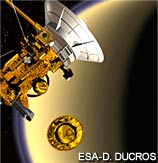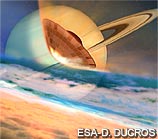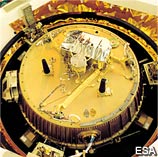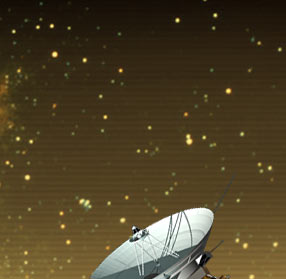 |
—— How did Huygens land on the surface of Titan?
|
As you know, the Huygens probe was transported to Titan by the Cassini orbiter. Cassini placed itself in position to deploy the probe along an orbit intersecting Titan. In order to maintain balance and stabilization, the probe, it was ejected with a spin.
At the beginning of the descent, as soon as the probe touched Titan's atmosphere, it transformed itself into basically an artificial meteorite. It was protected by a thermal shield, which kept it from burning up. At this point, we were at the beginning of the real part of the descent, and the probe started interacting with the atmosphere, becoming warmer and warmer, reaching a temperature of several thousand degrees. At the same time, the probe maintained its rotation, which gave it a kind of stabilization – just like a cannonball, which spins when it is shot out of a cannon. At this stage, the probe was completely enveloped by plasma, which does not allow any radio contact. This phase was very dangerous, because if we had been wrong about the composition of the atmosphere, the thermal shield could very well have failed.
But as we saw afterwards, everything went very well.
At this stage of the descent the speed was reduced. We deployed the first parachute, which detached the back cover of the probe. Now the probe was active. Another parachute was deployed, and the probe itself was extracted from the thermal shield, which fell towards Titan at its own speed, pulled by gravity. Meanwhile the probe continued descending, but very slowly, with a small rotation for stabilization, and started its scientific mission, sending information to the mother spacecraft, which was far away over the horizon.
About halfway down, a still smaller parachute was deployed, which accompanied the descent of the probe almost all the way down to the surface.
The oscillation of the probe was very violent through the descent, which we know from the onboard accelerometers.
Near the end of the descent, the third parachute was also detached, and for a short time the probe fell freely, until it touched down on the surface.
It was during this phase that the camera took the most impressive images of Titan.
The main focus of the Huygens mission was the study of Titan's atmosphere. That's why the probe has an atmospheric design, to penetrate safely through the atmosphere. We had no confidence at the beginning of the mission that we could land successfully on the surface of Titan, so this is a bonus. We thought the probe might survive for a few minutes, but that was just a hope. When we saw that the probe landed softly and safely, and continued to operate the instruments and take photographs of the surface, it was a huge surprise to all of us. It was an incredible pleasure seeing in real time the discovery of a new world. And it was also something that gave us confidence in our engineering, because we realized that the design was extremely good.
|
 |
 |
| Separation of Huygens from Cassini |

 |
| Huygens' atmosphere entry |

 |
| Huygens' descent sequence |
|
 |
—— When the probe was launched, did you still have the same concerns you had at the development stage of the mission?
|
We had to make sure that all the experiments could work, since we have no possibility, of course, of fixing anything once the mission is launched. So we decided to reproduce the Huygens probe on a smaller scale, and test it in Antarctica.
We deployed a mock-up of the probe from a stratospheric balloon, trying to reproduce the Titan mission, but in the atmosphere of our planet. It was extremely useful because we were able to test many different functions of the probe, and we also saw that the parachute was very effective in helping the probe land safely.
So that gave us a little bit of hope that maybe Huygens could survive during the actual mission. |
 |
 |
| This is the inner surface of Huygens' thermal shield. It detaches from the body as Huygens descends through the atmosphere, and when the probe lands on the surface it looks like a doughnut. All the scientific instruments are inside the body. |
|

 |
 |

